Q: Where do bladderworts (Utricularia) live?
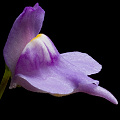
U. amethystina
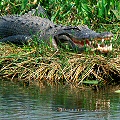
U. foliosa habitat,
Florida
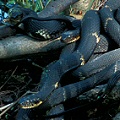
U. gibba habitat,
Louisiana
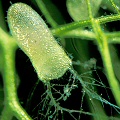
U. inflata
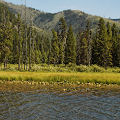
U. intermedia,
Idaho
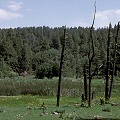
U. macrorhiza,
Arizona
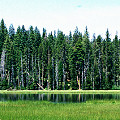
U. minor,
Oregon
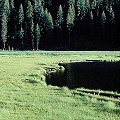
U. ochroleuca,
California
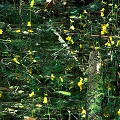
U. radiata, Florida
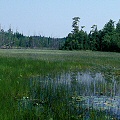
U. striata,
New Jersey
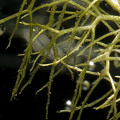
U. stygia
A: Utricularia is a global genus, with species found just about
everywhere. Indeed, there are species found in every state of the USA and every province of Canada.
The species list for the USA and Canada is given below. Along with the ranges, I annotate each species with the
letter "T" for terrestrial species and "SA"
for suspended aquatics. Some species such as U. intermedia or
U. intermedia can occur in very shallow, mucky conditions defying easy distinction as
aquatic or terrestrial, and I call these affixed aquatics ("AA"). Others like to live in soil, but under a few cm of water: these are
subaffixed aquatics ("SAA"). Species that grow on rocks are called lithophytes (L).
Sorry for the complications, but life is confusing sometimes.
USA: originally Florida (Lee, Collier counties) but probably now extinct within the country.
U. cornuta (T/SAA/L)
USA: every state east of the Mississippi river, with the possible exceptions of TN and WV; west of the river it occurs in MN, LA, AR, and TX. Washington reports are most certainly bogus.
U. floridana (AA)
USA: NC, SC, GA, FL, AL. In Florida, found in Alachua, Bay, Eustis, Gadsden, Holmes, Jackson, Lake, Leon, Pasco, Pinellas, Putnam, Wakulla, Watson, and Washington counties. A USA endemic species!
U. foliosa (SA)
USA: NC, GA, FL, LA, MS, TX.
U. geminiscapa (SA/AA)
Canada: (0ntario?), Quebec, Newfoundland, New Brunswick, Nova Scotia. USA: ME, NH, VT, NY, MI, WI, IA, MA, PA, CT, RI, NJ, DE, MD, VA, NC, (and WV?).
U. gibba (SA/AA)
Canada: Nova Scotia, New Brunswick, Quebec, Ontario, (Manitoba?), British Columbia. USA: every state except ND, SD, NE, IA, MT, WY, CO, NM, AZ, UT, ID, AK. Populations in NV (near Las Vegas) and Hawai'i are probably non-native.
U. inflata (SA)
USA: NY, NJ, DE, VA, KY, TN, AR, NC, SC, GA, FL, AL, LA, TX, WA. The populations in Washington are non-native; the nativity of NY plants are uncertain.
U. intermedia (AA)
Canada: all provinces. USA: AK, WA, OR, CA, NV, ID, MT, ND, MN, IA, WI, IL, MI, IN, OH, PA, DE, NJ, NY, CT, RI, MA, VT, NH, ME.
U. juncea (T/SAA)
USA: for the most part, coastal states: NY, NJ, DE, MD, VA, NC, SC, GA, FL, AL, MS, LA, and TX.
U. macrorhiza (SA)
Canada: All provinces. USA: all states except LA, MS, AL, GA, HI. Specimens from FL and SC are rare and probably ephemeral avian-assisted introductions.
U. minor (AA)
Canada: all provinces. USA: AK, WA, OR, CA, NV, ID, MT, UT, AZ, CO, WY, ND, SD, NE, MN, IA, IL, MI, IN, PA, NJ, NY, CT, RI, MA, VT, NH, ME.
U. ochroleuca (AA)
Canada: NW Territory, Ontario, Quebec, Manitoba, Nova Scotia. USA: AK, WA, OR, CA, CO, OH, IL, MI, MN.
U. olivacea (SA)
NJ, NC, SC, GA, FL.
U. purpurea (SA)
Canada: Ontario, Quebec, New Brunswick, Nova Scotia. USA: ME, NH, VT, MA, CT, NY, RI, NJ, PA, MI, IL, IN, DE, VA, NC, SC, GA, FL, AL, MS, LA, TX.
U. radiata (SA)
Nova Scotia. USA: ME, NH, MA, CT, NY, NJ, RI, PA, IN, DE, MD, VA, NC, SC, GA, FL, LA, AL, MS, TN, AR.
U. resupinata (SAA)
Canada: Ontario eastwards to Nova Scotia. USA: ME down to MD and PA, also in MI, IN. Disjunct range also in FL, GA.
U. simulans (T)
Florida; Dade, Broward, Collier, Lee, Highland, De Soto, Manatee, Hillsborough, Brevard, and Osceola counties.
U. striata (AA)
USA: MA, NY, NJ, DE, MD, VA, NC, SC, GA, FL, AL, MS, (CT, OK, TX?). One of only three species the USA can claim as being endemic.
U. stygia (AA)
Canada: Nova Scotia, Northwest Territories, Alberta (Ceska 2007). USA: AK, CA (the validity of the latter state depending upon your interpretation of what makes a species).
U. subulata (T)
Canada: Nova Scotia. USA: MA, RI, NY, NJ, DE, MD, VA, D.C., NC, SC, GA, FL, AL, TN, MS, LA, AR, TX.
Do you think I missed a species? Check the following list of no-longer-correct species names:
U. cleistogama........use U. subulata instead
U. fibrosa usually U. striata, sometimes U. gibba
U. inflata var. minor........use U. radiata instead
U. inflata var. radiata........use U. radiata instead
U. vulgaris........use U. macrorhiza for plants in the USA and Canada
U. vulgaris var./subsp. americana........use U. macrorhiza instead
U. vulgaris var./subsp. macrorhiza........use U. macrorhiza instead
In my species list, it is worth noting that U. amethystina
was only known in a few counties in southern Florida, but it has almost certainly
gone extinct there because of land destruction. Fortunately it occurs elsewhere
in the wild, but it is the first known extinction of a carnivorous plant
from the USA/Canada landscapes. Will the Floridian U.
simulans be the next to join this elite club?
The species U. stygia is very similar to U. ochroleuca, and has been reported in
a few Canadian sites. Some argue it may be in California, too!
To present this rather complicated pile of location information for the USA and Canada, I decided that range maps would be
particularly messy and would present an appearance of much greater knowledge than we actually have. So I have restricted my
presentation to mere presence/absence data for each state and province.
Here is how the map at right
is organized. (Not the thumbnail, but the full map that is displayed when
you click on the thumbnail!) First, each state has a number on it. This indicates
how many species are in that state. The states with the largest number of
species are Florida and New Jersey. The loser state with just one species
is New Mexico (with U. macrorhiza). Hawai'i is
a double-loser, because like New Mexico it only has one species, but its sole
species is the non-native introduction of U. gibba.
That blows.
Of course, this kind of presentation tends to favor the larger states, because with more area they should have more species, right?
So I divided the number of species in each state by the land area for the state. This resulted in a
species diversity measure. Then, I transformed this using a logarithmic scale to make a diversity index, and
used a color bar (as shown on the clickable map) to translate each index
value into a color to shade in each state.
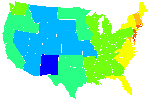
Utricularia Confused? Then listen to this explanation: the states colored blue have
the fewest species of Utricularia per area. The red states are the
biodiversity hot spots. The winners? Rhode Island and Delaware!
Clearly, the upper Atlantic coastal region is the most
biologically diverse area in the continent in terms of Utricularia.
The black numbers floating in the space to the north of the USA will
be of some significance to our Canadian friends.
Page citations: Ceska, A. 2007; Rice, B.A. 2006a;
Schnell, D.E. 1976, 2002a; Schlosser, E. 2003; Taylor, P. 1989; personal observation.